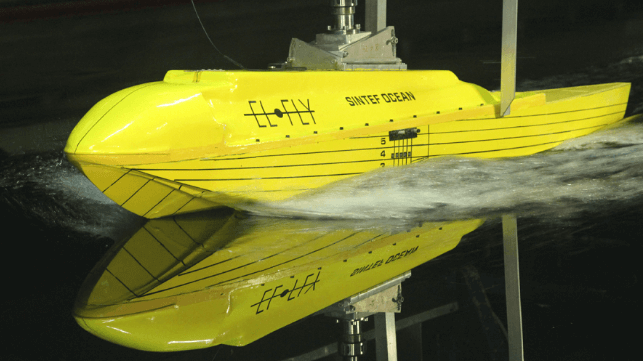Norwegian Startup Plans to Build Electric Seaplane for Coastal Routes

[By Håvard Egge]
A Norwegian company is developing a small electric seaplane that can change local passenger traffic on a large scale. The hull's design is now being tested at SINTEF 's tow tank in Trondheim.
"This is going to be a kind of battery-powered flying boat. The goal is for us to be able to offer flexible mobility in Norway, have zero emissions, significantly less noise pollution and develop new sustainable business models," says CEO of Elfly Eric Lithun.
The Research Council of Norway supports the seaplane initiative with funding of $1.8 million.
Futuristic hull
The new seaplane naturally needs a completely new type of design consisting of a boat hull at the bottom.
"It is especially important to develop the fuselage so that the aircraft can take off with the least possible force. The challenge will be to find the ultimate combination of aero- and hydrodynamics," says SINTEF researcher Kourosh Koushan.
This is challenging, among other things, because the propellers on the wings first push the nose of the fuselage into the water, before the aircraft gradually rises as it gains more speed.
In the video below you can see testing on one of the prototypes on the water:
Testing the hull in the towing tank
The work of developing the hull is in full swing. The experiments are performed in SINTEF's ship model tank in Trondheim. Here in the 260 meter long tank, a model of the hull is towed to find the optimal design.
"We test the hull by towing it at different angles, and look at how this affects the resistance in the water. This will give us data that we can use for a computer simulation of the take-off phase. We will compare the results to suggest improvements to the hull," says Koushan.
The Elfly Group has now reached version four of the fuselage. "It is a meticulous process and the measurements will result in new versions of the hull," Lithun says.
The research that will provide data for the design of the optimal hull is a separate research project supported by Norway's Regional Research Fund.
Alternative to helicopter?
If Elfly gets what they want, the aircraft of the future will be electric, environmentally friendly, quieter and can fly shorter routes.
"Here we are talking zero emissions and an electric motor that only makes a small "bzz" sound," says Lithun about the seaplane, which should both take off and land in water, but which also has wheels so that it can land and take off from airstrips.
"It must be able to fly 200 kilometers at about 250 kilometers per hour. Then the travel time on a flight from Bergen to Stavanger will be 40 minutes compared to four to five hours by car, says Lithun. "As the battery development gets two to three percent better every year, it is not long until we can fly longer. We envisage eventually being able to fly from Bergen to Trondheim via a stopover in Molde. This will be noticeable from center to center. It will beat all other options even with a stopover."
Lithun believes that the main reason why seaplanes are not already widespread is because today's aircraft have internal combustion engines that suck in oxygen and salt water that corrodes the engine.
"It leads to sky-high maintenance costs to operate. By switching to electricity, this problem disappears," he says.
From transport to exclusive travel
The aircraft's engine and battery must be purchased. The latter will weigh up to 1.7 tonnes, and should in theory be able to be charged anywhere. "We plan to use the same plug as for electric boats, which is also the one used by electric cars in the EU," Lithun says.
The electric seaplane will have room for nine passengers, and Elfly will offer flights on a par with other commercial players. "The goal is for us to have 15 to 20 aircraft in the air by 2030," says Lithun.
In addition to passenger travel, the seaplanes can also be used for freight transport, ambulance transport and premium flights where you can charter the entire aircraft. "We envisage that it can be used for exclusive electric plane safaris," says Lithun.
This article appears courtesy of Gemini News and is reproduced here in an abbreviated form. The original (in Norwegian) may be found here.
The opinions expressed herein are the author's and not necessarily those of The Maritime Executive.

